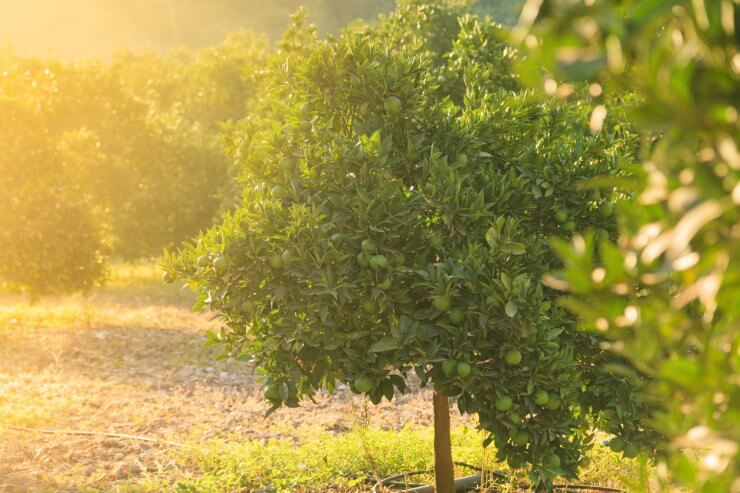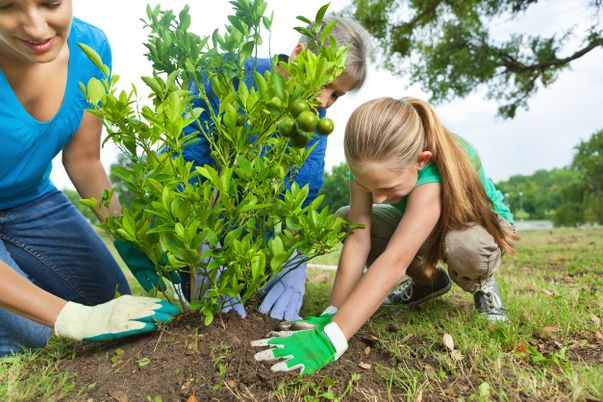
Young orange tree growing in the garden
Orange trees need lots of sunshine in order to thrive—six to eight hours of sunshine a day. Some varieties will tolerate a little shade, but that may reduce your harvest. They also need well-drained soil with a pH of 5.5 to 6.5. They don’t need a lot of fertilizer to get going; there are some standard times to add some fertilizer, which we cover in Watering, Weeding, Pruning, and Fertilizing Your Orange Trees.
Pick the highest appropriate spot on your property for good drainage, preferably on the south side of your home to give your tree maximum sun and to protect it from sudden temperature drops. To check for adequate drainage, dig a test hole 30 inches deep where you plan to plant your tree. Fill the hole with water. The next day, fill the hole with water again. If the water level drops 2 inches in two hours, it’s a good spot. If the water doesn’t drain at the right rate, you can build a raised bed that will provide the drainage your orange tree needs in order to avoid getting wet feet.
The easiest way to plant an orange tree is to order a tree from a reputable nursery so you get a tree suited for your area. Ordering young trees from a nursery is also a good way to get hardy trees that will be at least somewhat disease resistant.
Acclimation
When you first get your tree from the nursery, let it acclimate a little before you plunk it in the ground. You can put it outside by your house where it will get mostly indirect sunlight, with just a couple hours of direct sunlight each day. After a week, you can move your acclimated tree to where you plan to plant it.
One way to check whether your tree agrees with your chosen planting location is to leave it in its nursery container after it’s acclimated, and put it in the spot you have in mind. Keep it well watered. In a week or two, you’ll know if that’s the right spot for your tree.
As tempting as it might be, don’t plant your orange tree in your lawn; grass and orange trees have radically different water needs.
Planting

Family planting young orange tree
When you’re ready to plant your young tree, gently remove it from the container, keeping the soil intact. Check the root system; cut off any dead or broken roots before you plant the tree. Keep the roots out of the sun during this process.
Prepare a hole that’s just a little shallower than the root ball and about three times its diameter. If your soil is good, but not great, consider filling in the hole with half the soil you dug out and the remaining half with amended garden soil. (Miracle-Gro and other companies sell soil especially for this purpose.)
Place your tree in the hole and begin filling in with your soil. Tamp the soil gently as you’re filling in, so you remove air pockets. Don’t add fertilizer to the soil as you’re backfilling; you can provide a little fertilizer to the soil surface after planting and before watering. Do your young tree a favor and stake it until it’s settled in. If you want to make your life a little easier and give the stake some strength, put it in the hole alongside the trunk as you’re planting the tree.
It’s ideal to plant your orange tree during the active growing season, in the morning when temperatures are cooler. Be mindful of the tree’s roots and keep them out of the sun during the planting process.
Tree Spacing
If you’re planting more than one orange tree, plant them at least 15 feet apart, and give them at least 15 feet of clear space all around (away from fences, buildings, and other plants) to allow for good air circulation. The same orange trees that you can keep to a manageable size in containers will enjoy spreading out in open land. Consult with your nursery about the ideal spacing of your trees; depending on the variety, you may need up to 30 feet between trees.
One other advantage of planting more than one orange tree of the same cultivar is pollination. While most orange trees are self-fertile, having two trees will give you a more fruitful harvest from each one.
Companion Planting
Companion planting near your orange trees can help keep weeds away and attract pollinators. You can also get the benefit of an herb garden that does double duty to deter pests. Consider nasturtiums, alyssum, and lavender to attract bees. Plant garlic and chives to keep aphids and caterpillars off your trees. Thyme, dill, fennel, lemon balm, and oregano are also great herb choices.
Citrus trees love nitrogen, so consider planting peas or alfalfa near your orange trees. After you harvest your legumes, cut the plants back so they can release their nitrogen back into the soil.
If you’d like to grow some pretty flowering plants that do double duty as pest deterrents, consider black-eyed Susan, borage, calendula, or yarrow. These flowers attract lacewings, ladybugs, and hoverflies, which love to snack on mealybugs, one pest that can infest your orange tree.
How do you plant your orange trees? What criteria for site selection has worked for you? Do you include companion plants with your orange trees? Please share your ideas with us.


 Previous
Previous

